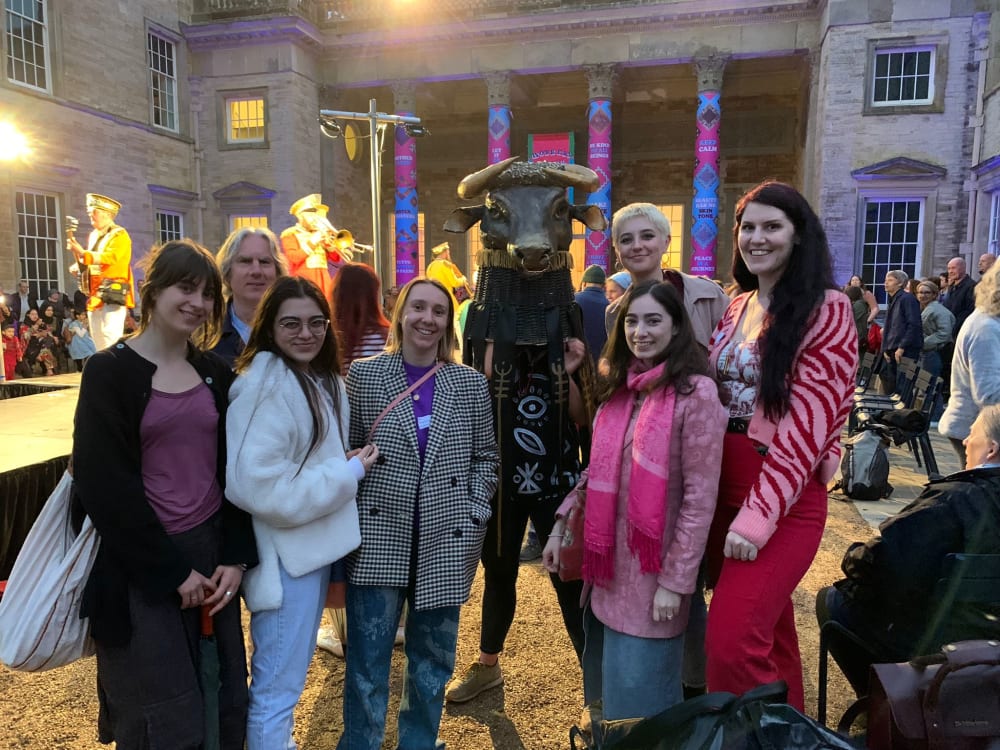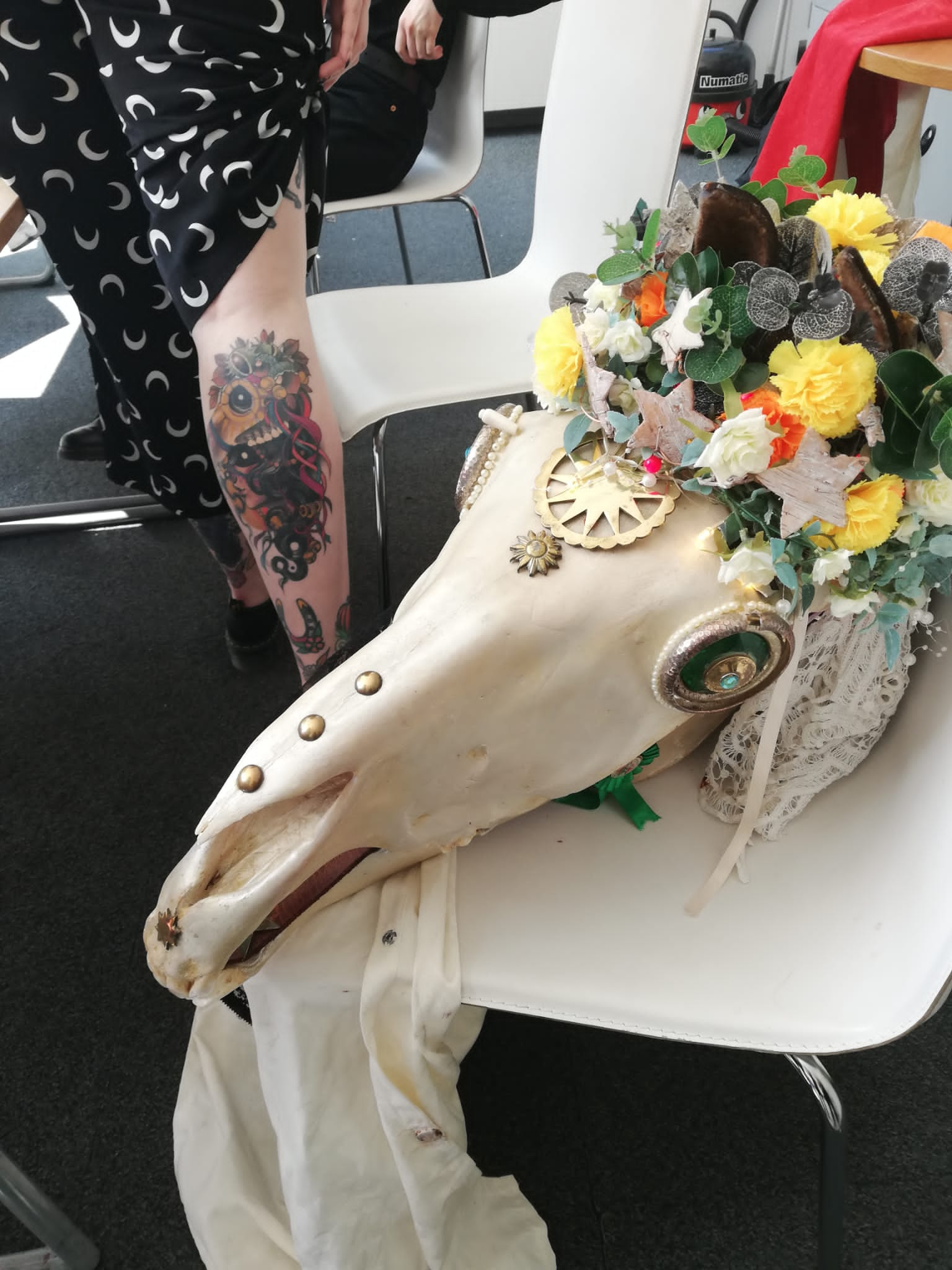
By preserving memories oral history redresses the balance of experience against artefacts, and although it records the experience of all, it is especially valuable in preserving the history of those whose material possessions have been meagre, contemporary and transitory.
Trevor Lummis, Listening to History [1]
This post records my experience and ideas having volunteered on an oral history project for the Centre for Fashion Curation (CfFC) in partnership with the Museum of British Folklore (MoBF), which involved interviewing makers, wearers and, various other participants of various British folk cultures about their costumes displayed in the exhibition 'Making Mischief: Folk Costume in Britain' at Compton Verney (11 February – 11 June 2023). This is an ongoing project with another exhibition being staged at LCF Stratford in April 2024.
A core objective of this National Lottery Heritage Funded project is to create and make accessible this living heritage in the Warwickshire archives and a London-based archive. Historians, students, artists, and more will be able to listen and engage with narratives of the folk costumes. After training and group meet-ups, I had the privilege of group interviewing participants of Jack in the Green, Mari Lwyds, Boss Morris, and conducted my first solo oral history interview with archivists from the Whitelands College about the May Day Monarch (previously, Queen) and May Day.
The other volunteers in the group came from various professional backgrounds, from studying their BA to artists to curators of museums. Our project manager was a member of the Oral History Society and a talented oral historian who guided us through the project. The Oral History Society is dedicated to the recordings of people’s memories, experiences and opinions [...] give those who have hidden from history a voice and it's a source of new insights into our past. [2]
This project has captured previously unheard voices, as well as broadened understandings of British folk costume which is, in many instances, an enigma to those who do not participate in these customs. Oral histories can assist with exploring people’s relationship with material culture, [3] making them a supportive source for the garments and objects on display in the Making Mischief exhibitions.
Our training comprised understanding what an oral history interview is, for example, the difference between an interview for an essay or a journalistic article. What might seem like a simple concept is important for gaining a strong oral history outcome. We were taught how to plan before the oral history interview and navigate one during to ensure our core themes were potentially discussed by the interviewee. In a blog for the Costume Society, Amy de la Haye stated, ‘We define folk costumes as the dressed appearance (including body adornment, jewellery, cosmetics, etc.) worn by participants to celebrate a particular date, season, person, occasion or story.' [4]
With this in mind, we collaboratively created an interview guide with five sections – background, the tradition, the costume/s, wearing the costume/s, and reflections and the future – as a method of creating a cohesive collection of oral histories relating to British folk costume narratives.
I saw the exhibition, with the other volunteers before Compton Verney’s ‘After Hours’ event. This was the first time we met in person, and it permitted us to collaboratively plan the project as aforementioned in our online training sessions thereafter. The ‘After Hours’ Making Mischief event involved a curator talk, a live performance by Boss Morris (an all-female morris dance group who has been in the media spotlight recently, including a performance at the Brit Awards 2023 for the band Wet Leg and various festival performances) and Mr Wilson’s Second Liners, as well as the unveiling of a new art piece by artist Jane Thakoordin in collaboration with local communities.

Understanding how to use the equipment was a vital part of the training. We used a Zoom recording device and after being allocated specific interviewees to interview about various folk customs and costumes, we had to pass the only two devices we had from participant to participant. However, the process of handing over was a wonderful way of discussing each other’s experiences in addition to regular online meetups.
From the outset, the event was thrillingly performative and began with a procession of visitors, Boss Morris and Mr Wilson’s Second Liners leading the way from the main entrance hut, over the bridge and up the path towards the manor house. The atmosphere of this moment and the evening thereafter, which hosted over four hundred guests, provided visitors with a folk experience they might not have previously experienced. Like music festivals many of us may have been to, these events can be photographed and videoed but the atmosphere and emotional response to everything around can only be captured by live experience.
After the fascinating curator's talk, a practicing morris dancer reflected on how the morris costume on display in the exhibition, mounted on a mannequin, felt dead because of the costume connection to the atmosphere, music, emotions, and bodily movement of wearing on the specific day of the folk tradition. This is of course a major issue when exhibiting dress that is worn on the animate body in museum spaces. Additionally, some smaller traditions find the costumes of wearers or makers inherited and thrown away or unused due to personal disinterest or the fading of a tradition. By archiving oral histories documenting a participant’s memories and emotional response to a custom and costume, lesser-known folk customs can live on regardless of if it is contemporarily practiced or not.

I felt fortunate to interview, as one of a group of three interviewers, two Mari Lwyd makers who owned and wore their Mari Lwyds during the Welsh twelve-night folk tradition. The wearer of the Mari Lwyd takes on the character of the dead horse’s head they wear, moving as the horse would and spiritually connecting with the skull which can be reimagined by listening to a wearer discuss their experience. Two of their Mari Lwyds were on display at Compton Verney for the exhibition. Seeing them displayed, like the morris dancer, evoked in the practitioners a sense of a lack of life in the garments they called ‘their girls’.

My first solo interview was with two archivists at the Whitelands College at the University of Roehampton in south-west London. The archive at the Whitelands College houses a wide variety of sources from each May Day, not just the dress worn each year; photographs, written diary accounts of the day, schoolbooks, etcetera, are preserved to retain a core part of the college's history. Over time, the day has diversified, and the monarchs were able to choose their dress, from the traditional dress of their own culture to prom styles and evening attire, the sense of community remains.
Participating in the project taught me the importance of oral histories and definitive differences from other forms of interviews. Every project has its challenges, and although some interviewees might be talkative some are not, but our comprehensive training and collaborative planning assisted with any obstacle. Overall, participating in the oral history project was insightful and inspiring and having the pleasure of listening to different folk custom experiences was truly fascinating.
'Making Mischief: Folk Costume in Britain' is travelling to the new LCF building in Stratford, East London in April 2024. The oral history project will continue to preserve memories of wearers and makers of folk costumes and the garments’ embodiment of a custom.
[1] Trevor Lummis (1987) 'Listening to History', 1987. Hutchinson Education: London, p. 154
[2] Oral History Society, quoted by Julia Letts
[3] Kevin Moore (2000) 'Museums and Popular Culture', 1997. Leicester University Press: London, p. 48.
[4] Amy de la Haye (2023) ‘Making Mischief: Folk Costume in Britain Exhibition’ Blog Post, The Costume Society [online]
Made possible by the National Lottery Heritage Grant, thanks to National Lottery players.


